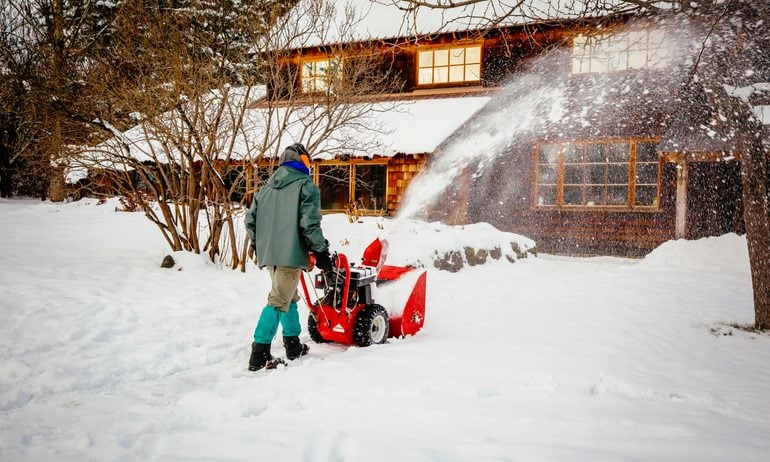What Is Hazard Insurance for Homeowners?
This coverage for the physical structure of your home is a standard part of a homeowners insurance policy.

Many, or all, of the products featured on this page are from our advertising partners who compensate us when you take certain actions on our website or click to take an action on their website. However, this does not influence our evaluations. Our opinions are our own. Here is a list of our partners and here's how we make money.
Hazard insurance is the part of a homeowners policy that covers the structure of your house.
Your lender will likely require you to have hazard insurance to get a mortgage.
Hazard insurance generally covers disasters such as fire, wind and hail.
Imagine that you’re getting ready to close on the house of your dreams, and then your lender demands to see proof that you have hazard insurance.
What do you do? You knew you'd have to get homeowners insurance as part of the mortgage closing process, but hazard insurance too?
Don’t worry. If you have homeowners insurance, you’re already covered.
All your insurance info, all in one place.
See your policies anytime, anywhere. Plus, get notified when it's time to renew or shop. Just link your insurance to your free NerdWallet account.
What is hazard insurance?
Hazard insurance is the part of a homeowners insurance policy that covers damage to your home's physical structure. It can pay to repair or rebuild your home after a fire, hailstorm or other disaster. You generally can't buy this type of insurance on its own.
Mortgage lenders typically use the term "hazard insurance" to refer to coverage for the structure of your home. To protect their investment, they'll often require you to have a certain amount of coverage before approving your mortgage.
Is hazard insurance the same as homeowners insurance?
Not exactly. Hazard insurance is another name for dwelling coverage, which is one part of a homeowners policy. Standard home insurance also offers other benefits, such as coverage for your personal belongings. And if you have to move out during covered repairs, your homeowners policy will help with additional living expenses.
Though the two types of coverage aren’t identical, purchasing a homeowners policy will usually satisfy your lender’s hazard insurance requirement.
What does hazard insurance cover?
Hazard insurance pays for damage to your home from certain causes such as fire, burst pipes and heavy snow. Most homeowners policies cover the structure of your home on an "open perils" or "all risks" basis. That means your policy will cover every cause of damage that isn't specifically excluded.
For example, a standard homeowners policy usually won’t cover:
Flooding from external sources, such as heavy rain.
Earthquakes.
Normal wear and tear.
Sewer backup.
War or nuclear action.
Intentional damage by the homeowner.
You may be able to add coverage for some of these perils. For example, you can buy flood insurance through the federal government or other private providers. (Depending on where you live, your lender might require it.) And many companies let you add coverage for sewer and drain backup for an extra cost.
Some homeowners have a more limited type of hazard insurance that covers their house on a "named perils" basis. These policies cover your home's structure only for specific listed events such as:
Fire or lightning.
Windstorm or hail.
Theft.
Smoke.
Vandalism.
Sudden damage from a power surge.
Weight of ice, snow or sleet.
Falling objects.
Explosions.
Riots.
Volcanic eruptions.
Water overflow or discharge from household systems like plumbing, air conditioning and appliances.
Freezing of those same household systems.
Sudden tearing, cracking or bulging of a hot water system, steam system, air conditioning or fire-protective system.
Damage caused by vehicles or aircraft.
How hazard insurance works
If your home suffers damage you think your policy should cover, your first step is to file a claim with your insurance company. Depending on your insurer, you may be able to do this by phone or online. Include photos or video of the damage if you can, plus as much detail as possible about what you lost.
Submit your claim as quickly as possible (once it’s safe to do so). Your policy may specify how long you have after the incident to report the damage. Learn more about how to file a home insurance claim.
Once the insurer approves your claim, your payout depends on how much the damage will cost to repair, how high your dwelling coverage limit is, and the amount of your deductible.
A homeowners insurance deductible is the amount of a claim you’re responsible for paying. Say you’ve chosen a $1,000 deductible, and a thunderstorm causes $5,000 of damage to your roof. Your insurance company would pay $4,000 and you'd cover the rest.
Your homeowners policy may have multiple deductibles — one for most claims and one that applies to certain perils, such as windstorms or named hurricanes. Check the homeowners insurance declarations page of your policy for details.
» MORE: Tips for first-time home buyers
How much hazard insurance do you need?
Hazard insurance covers your home up to a certain dollar amount, or limit. You’ll generally want a high enough limit to cover the full cost of rebuilding your home if it’s destroyed.
Keep in mind that this figure, known as the "replacement cost" of your home, isn’t necessarily the same as the property’s purchase price. Instead, it’s based on the estimated cost of materials and labor needed to rebuild the house to its pre-disaster condition. Your insurer can help you estimate the right amount.
For a little extra peace of mind, consider one of these optional types of coverage:
Extended replacement cost. When a hurricane or wildfire causes widespread damage in a certain region, local construction costs often go up due to higher demand. If this happens, your replacement cost coverage might not be enough. Extended replacement cost coverage offers a buffer against such shortfalls. You may be able to choose an amount anywhere from 10% to 50% above your coverage limit in case costs are higher than expected.
Guaranteed replacement cost. Going a step further, guaranteed replacement cost coverage pays as much as necessary above the dwelling coverage limit to rebuild your home.
How much does hazard insurance cost?
Because it’s part of your homeowners insurance coverage, hazard insurance doesn't cost extra if you already have a standard policy. The average cost of homeowners insurance in the U.S. is $2,110 per year, according to NerdWallet’s rate analysis. Your own cost may differ depending on where you live, the size of your home and how much coverage you need.
It'll cost extra to add coverage for disasters a homeowners policy doesn't typically include, such as flooding or earthquakes.
All your insurance info, all in one place.
See your policies anytime, anywhere. Plus, get notified when it's time to renew or shop. Just link your insurance to your free NerdWallet account.
How to get a hazard insurance policy
Most major insurers sell homeowners policies, which include hazard insurance. You can look for home insurance quotes online or ask an independent insurance agent to shop around on your behalf. To get the best price, it’s smart to compare quotes from at least three insurers.
Not sure where to start? Consider NerdWallet’s list of the best home insurance companies.
If you’ve already got car insurance, start with a call to your existing insurer. Most insurance companies offer bundling discounts if you buy both auto and homeowners insurance from them. However, it’s still worth comparing quotes from other companies to make sure you’re getting the best deal on all your policies.
NerdWallet calculated median rates for 40-year-old homeowners from various insurance companies in the 25 largest cities in each state by population. All rates are rounded to the nearest $5.
Sample homeowners were nonsmokers with good credit living in a single-family, two-story home built in 1984. They had a $1,000 deductible and the following coverage limits:
$300,000 in dwelling coverage.
$30,000 in other structures coverage.
$150,000 in personal property coverage.
$60,000 in loss of use coverage.
$300,000 in liability coverage.
$1,000 in medical payments coverage.
We made minor changes to the sample policy in cases where rates for the above coverage limits or deductibles weren’t available.
These are sample rates generated through Quadrant Information Services. Your own rates will be different.


